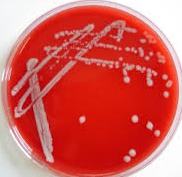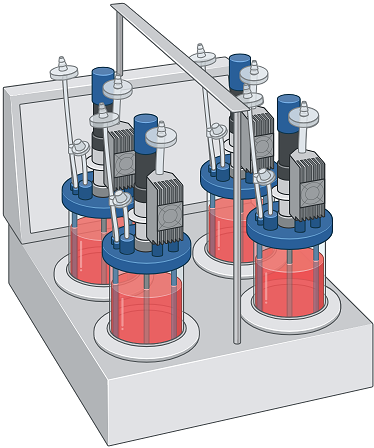Microorganisms—including bacteria (e.g. Escherichia coli, Bacillus subtilis), fungi (yeasts like Saccharomyces cerevisiae and Pichia pastoris, and molds like Aspergillus), actinomycetes (Streptomyces), and even viruses (phage-display systems)—possess a suite of features that distinguish them from higher eukaryotes, making them indispensable tools in industrial biotechnology. Their rapid growth, genetic manageability, and biochemical versatility enable production of a wide array of high-value products: pharmaceuticals (insulin, vaccines), enzymes, organic acids, biofuels, and fermented foods. Below, is a comprehensively expanded key trait of microorganisms used for industrial production and how they align with industrial selection criteria for microbial strains.
1. Minimal Nutritional Needs and Cost‑Effective Growth
Industrial microbes must thrive on inexpensive, simple media to ensure economic viability. Complex supplements like preformed amino acids or vitamins drive up production costs. Therefore, strains are optimized for growth on basic carbon and nitrogen sources—such as glucose, glycerol, or methanol—and common mineral salts.
For example, Pichia pastoris can achieve high cell densities using minimal media with methanol or glucose as carbon sources . Similarly, S. cerevisiae strains are engineered to utilize diverse feedstocks—including starch, lignocellulose hydrolysates, and whey—through the expression of hydrolytic enzymes and heterologous pathways. This metabolic flexibility not only minimizes feedstock costs, but also contributes to circular bioeconomy goals.
2. Safe, Non‑toxic End‑Products (GRAS Status)
Industrial production often targets food-grade, pharmaceutical, or feed applications, which require non-toxic metabolites. Many industrial microbes fall under the GRAS category (Generally Recognized As Safe by FDA standards), signifying non‑pathogenic status and safe metabolism.
For instance, S. cerevisiae is GRAS-certified, broadly used in both food and pharmaceutical industries. Likewise, Corynebacterium glutamicum is extensively used for amino-acid and nucleotide production with established safety records . Safety extends beyond taxonomy; secretion of toxic byproducts is strictly minimized through pathway engineering.
3. Rapid Growth Rates and Short Generation Times
Fast growth accelerates production cycles, boosts yields, and decreases contamination risk. For example:
- S. cerevisiae doubles every 1.25–2 hours at 30 °C under optimal conditions.
- B. subtilis, historically considered strictly aerobic, can grow under microaerobic or facultative conditions, enhancing its process adaptability .
Rapid doubling times reduce batch durations, increasing throughput and economic efficiency.
4. High Yield and Selectivity for Desired Products
Industrial strains must convert substrates into desired products with high yield and minimal by-products. This involves:
- Flux optimization: e.g., metabolic engineering of E. coli or S. cerevisiae to route glucose toward ethanol with suppressing competitive pathways.
- Tolerance enhancement: engineering resistance to inhibitors like furfural, acetic acid, and hydroxymethylfurfural, especially relevant for lignocellulosic fermentations .
- Secondary metabolite production: e.g., production of salidroside, resveratrol, or artemisinic acid in yeast for pharmaceuticals.
High yield ensures profitability and lessens purification challenges.
5. Genetic Amenability and Engineering Tools
Modern industrial strain development relies on precise genetic manipulation:
- Transformation systems: S. cerevisiae allows transformation via homologous recombination with high efficiency, and is compatible with CRISPR/Cas9 systems.
- Integrated vector systems: e.g., AOX1 promoter in Pichia pastoris, YEp/YIp plasmid systems in yeast.
- Codon optimization and regulatory elements tuning: promoters, terminators, fusion tags for secretion, and ER chaperone co-expression to improve protein yield.
- Systems and synthetic biology: genome-scale metabolic models, modular expression cassettes, multiplexed Cas editing tools, and synthetic genome projects (e.g., Sc2.0).
These tools enable iterative “Design–Build–Test–Learn” cycles, crucial for robust strain improvement.
6. Resistance to Biotic and Abiotic Stress
Industrial fermentations are prone to contamination and inhibitory environments. Successful strains exhibit resilience:
- Phage/Bacteria resistance: crucial for lactic acid bacteria in dairy; CRISPR spacers can be harnessed for phage defense.
- Tolerance to stressors: engineered S. cerevisiae strains withstand high ethanol, inhibitors in lignocellulose, temperature shifts, or osmotic stress via overexpression of HSPs and stress-defense genes .
- Environmental robustness: e.g., hot or acidophilic yeast strains, industrial B. subtilis for enzyme production in alkaline conditions .
Such resilience supports stable operation under industrial constraints.
7. Genetic and Physiological Stability
For reproducibility and regulatory compliance, strains must retain stable performance across generations:
- Chromosomal integration: eliminates plasmid loss or antibiotic selection pressure.
- Avoidance of mobile genetic elements: reduces risk of unintended genetic drift.
- Auxotrophic selection systems: ensure maintenance of desired traits without antibiotics.
- Synthetic genomics: projects like Sc2.0 integrate “stability by design” with optimized genomes free of unnecessary elements.
Stable strains limit batch variability and regulatory burden.
8. Efficient Product Recovery (Secretion and Localization)
Downstream processing drastically impacts cost:
- Secretion of Target Molecules: B. subtilis and C. glutamicum secrete enzymes or amino acids directly into the medium.
- Filamentous fungi: e.g., Aspergillus niger and Mucor secrete large amounts of industrial enzymes and organic acids.
- Intracellular Products: When intracellular accumulation is favorable (e.g., poly-hydroxyalkanoates), strains are engineered for easy lysis or auto-lysis.
- Cell aggregation/flocculation: Leveraging FLO genes in yeast to simplify yeast–product separation.
Simplified recovery improves process economics significantly.
9. Aerobic and Anaerobic Balance (Oxygen Demand)
Oxygen transfer is energy-intensive. Strains are chosen/designed to minimize this need:
- Facultative anaerobes: S. cerevisiae thrives anaerobically for ethanol or aerobically for biomass.
- Microaerophiles: B. subtilis can grow under low oxygen, reducing aeration cost.
- Enzyme engineering: Overexpressing water-forming NADH oxidase or alternative oxidases to reduce fermentation-caused overflow metabolism.
- Anaerobic bacterium use: Clostridium acetobutylicum generates solvents like butanol without air exposure.
Optimizing oxygen use lowers energy and equipment demands.
10. Adaptive Range for pH, Temperature, and Medium
Industrial processes must operate under diverse conditions:
- Temperature Profiles: From mesophiles (e.g., yeast, ~30 °C) to thermophiles (Thermoanaerobacterium) for high-temperature fermentations, improving process rates and reducing cooling requirements.
- pH Ranges: Acid-tolerant fungi (e.g., A. niger) are used for organic acid production, while alkaline-tolerant Bacillus strains support enzymatic processes.
- Trace metal utilization: Some strains employ genetic engineering to optimize uptake and binding of essential metals—e.g., yeast engineered for copper binding in winemaking .
Operating within these ranges enhances scalability and robustness.
11. Taxonomic Diversity and Product Examples
A variety of microorganisms are harnessed for their unique metabolic capabilities.
Table 1. Some microorganisms of industrial importance and their products
| Organism | Product/Application |
| Penicillium, Streptomyces, Bacillus | Antibiotics (e.g., penicillin, streptomycin) |
| Recombinant E. coli, S. cerevisiae | Insulin, vaccines (pharmaceuticals) |
| Claviceps purpurea | Ergoline alkaloids (e.g., ergotamine) |
| Rhizopus, Arthrobacter | Steroid intermediates |
| S. cerevisiae, Zymomonas | Ethanol (biofuel, beverages) |
| Clostridium acetobutylicum | Acetone and butanol (solvents) |
| Mucor, Aspergillus, Bacillus | Industrial enzymes (amylases, proteases) |
| Corynebacterium glutamicum | Amino acids (lysine, glutamate), nucleotides |
| Aspergillus niger | Citric acid, gluconic acid (organic acids) |
| Methanobacterium | Methane (biogas production) |
| Photosynthetic microbes | Hydrogen (biofuel research) |
| Lactobacillus bulgaricus | Yogurt and fermented dairy |
12. Case Studies: Industrial Microbial Platforms
A. Saccharomyces cerevisiae
- Doubling time of ~1.25–2 hr; eukaryotic features like organelles and post-translational capabilities.
- Widely used in food (bread, beer, wine), biofuels, and recombinant protein production.
- Genetically engineered for biochemicals: resveratrol, salidroside, artemisinic acid, stilbenoids.
- Strategic removal of Crabtree effect (overflow ethanol) via transporter engineering or oxidase expression.
- Synthetic genome (Sc2.0) enables more controllable and stable chassis.
B. Pichia pastoris (Komagataella phaffii)
- Eukaryotic, capable of post-translational modifications and high-density growth .
- Methanol-inducible AOX1 promoter drives potent heterologous protein expression.
- Effective glycosylation pathways enhance therapeutic protein production.
C. Bacillus subtilis
- Forms stress-resistant spores; secretory capacity of 20–25 g/L extracellular enzymes.
- Used extensively for industrial enzyme production and fermentation processes.
- Genetically tractable, free from endotoxins, and capable of secreting high-quality proteins intimately suited for detergent and food applications.
D. Corynebacterium glutamicum
- Non-pathogenic and effective for amino-acid and nucleotide production
- Known for high-volume industrial fermentations (e.g., glutamate and lysine) .
E. Clostridium acetobutylicum
- Solventogenic anaerobe producing acetone and butanol (A/B fermentation).
- Utilized in early industrial bioprocesses and revived via metabolic engineering for renewable solvent production.
13. Strain and Process Engineering Strategies
A. Metabolic Engineering
- Pathway optimization: Enhancing precursor availability (e.g., SAM for methyl transfers, FAME for biodiesel) increasing yields by >2–7 fold.
- Inhibitor tolerance: Overexpression of ADH6, ARI1, PAD1 confers resistance to lignocellulosic byproducts.
- High-value chemical production: Engineering yeast for lactic, succinic, levulinic acids, hydrogen, and beyond.
B. Evolutionary Engineering
- Selective adaptation under industrial conditions—e.g., hybrid yeast strains selected for efficient sugar consumption and flavor profile development for new beer styles.
- Multi-gene insertion and challenge-resistant sequencing in yeast and bacteria.
C. Systems & Synthetic Biology Approaches
- Genome-scale metabolic models (GEMs) inform rational design.
- Modular genetic toolkits (promoters, terminators, Cas systems, chaperones) streamline production pipelines.
- Synthetic genome designs (Sc2.0, synXVI) laying foundations for synthetic life and bio-manufacturing ecosystems.
14. Economic and Environmental Considerations
A. Feedstock Economics
- Use of low-cost, renewable feedstocks (lignocellulosics, waste glycerol, whey) reduces input costs and valorizes waste.
- Circular economy integration, reducing raw material footprint.
B. Energy and Process Efficiency
- Minimizing oxygen demand lowers aeration costs.
- Choosing thermotolerant strains saves cooling energy; pH-resilient organisms reduce buffer usage.
C. Downstream and Recovery Costs
- Secreted products lower separation costs.
- Autolysis or flocculation systems reduce processing steps and energy usage.
D. Biocontainment and Sustainability
- Synthetic auxotrophy and kill switches prevent environmental dissemination.
- Closed-loop fermentations reduce effluent and microbial escape.
15. Emerging Technologies and Future Prospects
A. Synthetic Genomes and Designer Microbes
- Entire synthetic yeast chromosomes (Sc2.0) enable optimized, modular microbial chassis; synthetic tRNA neochromosomes increase stress tolerance.
- Customizable microbial genomes for specific industrial purposes (e.g., climate-adaptive production strains).
B. Advanced Gene Editing
- Multiplex Cas9, Cas12a, CRISPR-D-BUGS enable rapid, precise strain refinement.
- Genome-wide adaptive selection under industrial stresses.
C. Modular Bioprocess Platforms
- Plug-and-play standardized modules for promoter–gene–terminator systems streamline biofactory construction.
- Synthetic biology platforms reduce time and cost in strain development.
D. Integrated Bioeconomy Frameworks
- Production of bioplastics, biofuels, and biochemicals using microbes supports circular metabolisms.
- Coupling microbial processes to carbon-neutral energy systems (biohydrogen, biomethane).
16. Conclusion
Microorganisms form the backbone of industrial biotechnology thanks to:
- Rapid, economical growth on minimal media
- Safe, targeted product formation
- High-yield conversion efficiency
- Robust genetic and metabolic engineering capacity
- Stress resilience and process stability
- Effective product secretion or recovery
- Versatility in physical and chemical tolerance
Through strategic integration of these traits with engineering and synthetic biology frameworks, microbial systems are evolving as customizable, efficient platforms for sustainable production of food, medicine, energy, and materials. The future lies in fully synthetic genomes, modular biofactories, and closed-loop sustainable bioprocesses—ushering in a new era of microbial-powered industry.
References
Bader F.G (1992). Evolution in fermentation facility design from antibiotics to recombinant proteins in Harnessing Biotechnology for the 21st century (eds. Ladisch, M.R. and Bose, A.) American Chemical Society, Washington DC. Pp. 228–231.
Nduka Okafor (2007). Modern industrial microbiology and biotechnology. First edition. Science Publishers, New Hampshire, USA.
Das H.K (2008). Textbook of Biotechnology. Third edition. Wiley-India ltd., New Delhi, India.
Latha C.D.S and Rao D.B (2007). Microbial Biotechnology. First edition. Discovery Publishing House (DPH), Darya Ganj, New Delhi, India.
Nester E.W, Anderson D.G, Roberts C.E and Nester M.T (2009). Microbiology: A Human Perspective. Sixth edition. McGraw-Hill Companies, Inc, New York, USA.
Steele D.B and Stowers M.D (1991). Techniques for the Selection of Industrially Important Microorganisms. Annual Review of Microbiology, 45:89-106.
Pelczar M.J Jr, Chan E.C.S, Krieg N.R (1993). Microbiology: Concepts and Applications. McGraw-Hill, USA.
Prescott L.M., Harley J.P and Klein D.A (2005). Microbiology. 6th ed. McGraw Hill Publishers, USA.
Steele D.B and Stowers M.D (1991). Techniques for the Selection of Industrially Important Microorganisms. Annual Review of Microbiology, 45:89-106.
Summers W.C (2000). History of microbiology. In Encyclopedia of microbiology, vol. 2, J. Lederberg, editor, 677–97. San Diego: Academic Press.
Talaro, Kathleen P (2005). Foundations in Microbiology. 5th edition. McGraw-Hill Companies Inc., New York, USA.
Thakur I.S (2010). Industrial Biotechnology: Problems and Remedies. First edition. I.K. International Pvt. Ltd. New Delhi, India.
Discover more from Microbiology Class
Subscribe to get the latest posts sent to your email.





